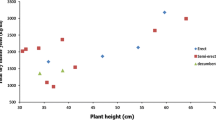Summary
The drought resistance of 25 accessions of meadow fescue (Festuca pratensis Huds.) from seven countries was investigated in four experiments: two in the glasshouse using pot-grown plants from which water was withheld for various periods, and two in controlled environments under osmotic stress.
There were significant differences between populations (‘broad-sense heritabilities’ or ‘repeatabilities’) in all four experiments. In the glasshouse there was a large residual effect of yield potential on production during and after slight-to-moderate drought, and different susceptibilities appeared only after very severe drought. The most consistently high-yielding accessions were from the Bergamo alps in Italy. Recovery after drought was strongly correlated with tiller survival. Continued production under moderate drought was considered important in wetter climates, whereas survival and recovery under severe drought was often associated with low production or flowering in the seeding year, and more typical of summer-drought climates.
Leaf growth rates of plants subjected to zero or moderate osmotic stress were correlated with yields of irrigated or moderately-stressed plants in the glasshouse, although there was no differential susceptibility to mild stress. Under severe osmotic stress there were very large differences in survival between populations, but there was no relationship with survival under glasshouse conditions.
The inconsistency of population rankings across experiments shows that no one technique gives a full evaluation of drought resistance, and emphasizes the complex nature of the phenomenon. It was possible, however, to identify (a) regions meriting further collections, and (b) ecotypes that had desirable responses in all experiments and could contribute to variety improvement.
Similar content being viewed by others
References
Becker, W. A., 1975. Manual of Quantitative Genetics. Students' Book Corporation, Washington.
Bhaskaran, S., R.H., Smith and R.J., Newton, 1986. Physiological changes in cultured sorghum cells in response to induced water stress. 1. Free proline. Plant Physiol 79: 266–269.
Blum, A., 1988. Plant Breeding for Stress Environments. CRC Press, Boca Raton.
Blum, A. & C.Y., Sullivan, 1986. The comparative drought resistance of landraces of sorghum and millet from dry and humid regions. Ann Bot 57: 835–846.
Byrne, P. F., J., Bolanos, G.O., Edmeades & D., Eaton, 1995. Gains from selection under drought versus multi-location testing in related tropical maize populations. Crop Sci 35: 63–69.
Eagles, C. F., 1989. Temperature-induced changes in cold tolerance of Lolium perenne. J Agric Sci 113: 339–347.
Edmeades, G. O., J., Bolanos J., H.R., Lafitte, S., Rajaram, W., Pfeiffer & R.A., Fischer, 1989. Traditional approaches for breeding for drought resistance in cereals. In: F.W.G., Baker (Ed.), Drought Resistance in Cereals, pp. 27–52. CAB International, Wallingford, Oxford.
Hurkman, W.J. & C.K., Tanaka, 1988. Polypeptide changes induced by salt stress, water deficit and osmotic stress in barley roots: A comparison using two-dimensional gel electrophoresis. Electrophoresis 9: 781–787.
Kendrew, W. G., 1961. The Climates of the Continents. Oxford University Press.
May, L. H. & F.L., Milthorpe, 1962. Drought resistance of crop plants. Field Crop Abs 15: 171–179.
Morgan, J. M., 1988. The use of coleoptile responses to water stress to differentiate wheat genotypes for osmoregulation, growth and yield. Ann Bot 62: 193–198.
Murashige, P. & Skoog, F., 1962. A revised medium for rapid growth and bioassay with tobacco tissue culture. Physiol Plant 15: 473–497.
Newton, R. J., S., Bhaskaran, J.D., Puryear & R.H., Smith, 1986. Physiological changes in cultured sorghum cells in response to induced water stress. II. Soluble carbohydrates and organic acids. Plant Physiol 81: 626–629.
Norris, I. B. & H., Thomas, 1982. Variation in growth of varieties and ecotypes of Lolium, Dactylis and Festuca subjected to contrasting soil moisture regimes. J Appl Ecol 19: 881–889.
Richards, R. A., 1994. Breeding crops with improved stress resistance. In T.J., Close & E.A., Bray (Eds), Plant Responses to Cellular Dehydration during Environmental Stress. American Society of Plant Physiologists, Riverside, Ca.
Sullivan, C. Y. & W.M., Ross, 1979. Selecting for drought and heat resistance in grain sorghum. In H., Mussell & R. C., Staples (Eds), Stress Physiology in Crop Plants, pp. 263–281. Wiley, New York.
Thomas, H., 1986. Effects of rate of dehydration on leaf water stress and osmotic adjustment in Dactylis glomerata L., Lolium perenne L. and L. multiflorum Lam. Ann Bot 57: 225–235.
Thomas, H., 1987. Physiological responses to drought of Lolium perenne L.: measurement of, and genetic variation in, water potential, solute potential, elasticity and cell hydration. J Exp Bot 38: 115–225.
Thomas, H., 1994. Diversity between and within temperate forage grass species in drought resistance water use and related physiological responses. Asp Appl Biol 38: 47–55.
Thomas, H. & I.B. Norris, 1981. Evaluation of drought resistance of grass and clover populations grown in containers. In C.E. Wright (Ed.) Plant Physiology, and Herbage Production, BGS Occasional Symposium No. 13.
Tyler, B.F. (Ed.), 1987. Collection, characterization and utilization of genetic resources of temperate forage grass and clover. IBPGR Secretariat, Rome.
Volaire, F., 1995. Growth, carbohydrate reserves and drought survival strategies of contrasting Dactylis glomerata populations in a Mediterranean environment. J Appl Ecol 32: 56–66.
Walter, H & H., Lieth, 1967. Klimadiagramm-weltatlas. Gustav Fischer, Jena.
Author information
Authors and Affiliations
Rights and permissions
About this article
Cite this article
Thomas, H., Dalton, S.J., Evans, C. et al. Evaluating drought resistance in germplasm of meadow fescue. Euphytica 92, 401–411 (1995). https://doi.org/10.1007/BF00037125
Received:
Accepted:
Issue Date:
DOI: https://doi.org/10.1007/BF00037125




